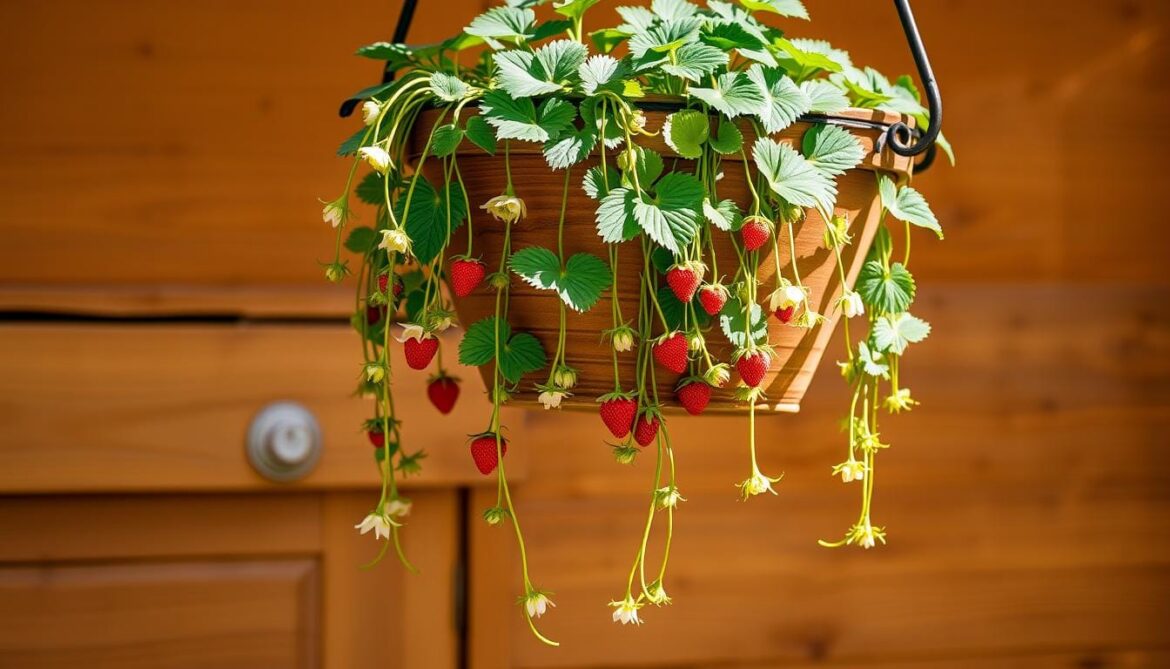Imagine biting into a sun-ripened strawberry, picked just moments ago from a garden hanging outside your window. For many, growing fresh fruit seems impossible—until now. Hanging strawberry plants transform small areas into lively, fruitful spots. They’re perfect for balcony owners or those with limited space, allowing you to enjoy homegrown berries without giving up style or room.
Imagine lush greenery spilling over a planter, with ruby-red strawberries scattered among it. A hanging strawberry plant is more than just a crop—it’s a piece of living art. These gardens flourish in tight spaces, showing even the smallest areas can burst with flavor and beauty. No need to dream of big orchards anymore; your vertical garden is a daily reminder of the joy in small, delicious packages.
Key Takeaways
- Hanging strawberry plants save space while producing juicy, fresh berries.
- Vertical gardens add visual charm to patios, porches, or decks.
- Easy maintenance makes them perfect for beginners and busy gardeners.
- Grow your own fruit without sacrificing precious yard or balcony space.
- Hanging strawberry plant ideas let you customize your garden’s look and function.
What Are Hanging Strawberry Plants?
Hanging strawberry plants are a way to grow strawberries in the air. They use strawberry plant hangers or special pots to hang plants. This makes lush greenery and fruit grow in small spaces.
They are great for patios, balconies, or sunny porches. They change how strawberries grow without needing soil.
Definition and Overview
Vertical strawberry setups use light containers like fabric pockets or wire frames. A strawberry plant hanger has a strong base. This lets roots hang while leaves and fruit face out.
This method works with any strawberry type. But it’s best for small varieties like Ozark Beauty or Alpine strawberries. The roots stay moist, and the stems get sunlight and air.
Benefits of Growing Vertically
- Space efficiency: Fits 3–5 plants in the space of one ground bed.
- Less disease risk: Elevates plants above soil pests like slugs and fungus-prone ground.
- Easy harvesting: Berries hang at eye level, reducing bending or weeding.
- Decorative appeal: Adds vertical charm to decks or entryways.
Unlike traditional beds, vertical systems reduce soil compaction and let roots breathe. They are perfect for urban gardens. They also let sunlight reach all sides of the plant, boosting fruit yield.
Whether you make your own or buy hangers, this method is for everyone.
Ideal Varieties for Hanging Gardens
Choosing the right strawberry varieties is key for your best hanging strawberry plant. These varieties do well in containers and vertical setups. They give consistent yields without taking up too much space.
Top Varieties for Vertical Growth
Look for compact, disease-resistant types. Alpine strawberries are small and produce sweet berries all year. Ozark Beauty does well in containers with its trailing stems. For a steady summer harvest, try Evie or Chandler, which are easy to manage.
Beginner-Friendly Choices
- Alpine varieties: Easy to care for and tolerate partial shade.
- Everbearing types like Seascape offer steady fruiting without seasonal downtime.
- Day-neutral options such as Tristar bloom based on temperature, not daylight.
Beginners should start with Tristar or Seascape. They resist common pests and adapt to different climates. Use lightweight soil mixes in porous containers for good drainage.
Benefits of a Hanging Strawberry Plant
Vertical strawberry gardens are great for those with little space. A hanging strawberry plant turns small spots like patios or balconies into useful areas. They make the most of space without needing big areas, perfect for city living.
Space-Saving Advantages
Grow strawberries in tight spots by using vertical space. Unlike ground beds, tips for hanging strawberry plants focus on small setups. Hang containers above ground to use soil for other plants. They’re great for small apartments or tiny yards, turning walls and railings into growing areas.
Aesthetic Appeal
“A well-designed hanging garden is both a feast for the eyes and the palate.”
Cascading greenery and red berries add color to any spot. Their lush leaves create moving decor. Place them near doors or water for stunning views. The mix of leaves and fruit catches the eye without needing constant care.
Easier Maintenance
- No soil weeding required
- Reduced pest access compared to ground-level plants
- Harvesting at eye level minimizes bending
Check plants easily by stepping back to see all sides. Air flowing around containers keeps mold and disease away. Quick checks keep plants healthy with little effort.
Essential Supplies for Hanging Strawberry Gardens
Starting a hanging strawberry garden needs the right materials. This ensures healthy plants and plenty of strawberries. Choose items that are durable, drain well, and keep plants healthy for a long time.
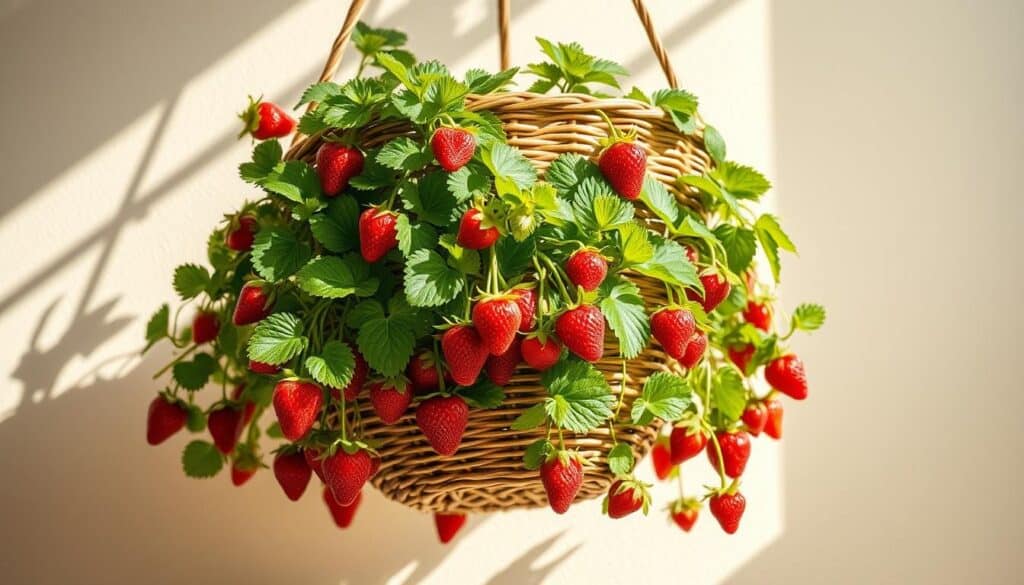
Choosing the Right Containers
Containers must have good drainage and support the roots. You can pick from:
- Hanging baskets with coconut coir liners to keep moisture in
- Specialty strawberry pots with many planting pockets
- Vertical felt pouches for easy setups
- DIY hanging strawberry plant systems using recycled materials like mesh bins
Go for materials that breathe and make sure each container has holes for drainage. This stops root rot.
Recommended Soil Mixes
A good mix balances aeration and moisture. A mix that works well includes:
| Component | Percentage |
|---|---|
| Premier potting soil | 60% |
| Coir or perlite | 30% |
| Organic compost | 10% |
Stay away from heavy garden soil. It can compact in hanging baskets.
Necessary Tools and Accessories
Key tools are:
- Sturdy hooks rated for at least 20 lbs
- Watering cans with long spouts for precise watering
- Slow-release fertilizer pellets
- Support chains or stands for adjusting heights
Choose UV-resistant materials to make containers last longer outside.
Best Locations for Hanging Strawberry Plants
Choosing the right spot is key for your hanging strawberry plant to do well. Whether it’s outside or inside, the right spot helps it grow and produce fruit. Here are some tips to help you create the perfect spot.
Sunlight Requirements
Strawberries need 6–8 hours of sunlight every day. For outdoor plants, put them in a spot that gets morning sun. In very hot places, give them some shade in the afternoon.
South-facing spots like porches or patios are great for hanging strawberry plants.
- Make sure the spot gets enough light without shadows.
- Turn the plants every week to get even light.
Optimal Temperature and Climate
The best temperature for strawberries is between 60–80°F (15–27°C). Use this table to find the best spot for your area:
| USDA Zone | Optimal Temp Range | Winter Care |
|---|---|---|
| Zones 3–6 | Protect from frost with blankets | Use microclimate shelters |
| Zones 7–10 | Partial shade in summer heat | None required |
Indoor Growing Considerations
For indoor hanging strawberry plants, add extra light with LED grow lights. Keep the room between 65–75°F (18–24°C). Use a humidifier if the air is too dry.
“East-facing windowsills are perfect for indoor setups—they balance light and warmth.” — Urban Farmer Journal
Move your plants around as the seasons change and the weather shifts. This helps them stay healthy.
Planting Techniques for Hanging Strawberries
Learning how to plant your hanging strawberry plant right is key. Choose a strong container that lets water drain well. Here’s how to create a great vertical garden:
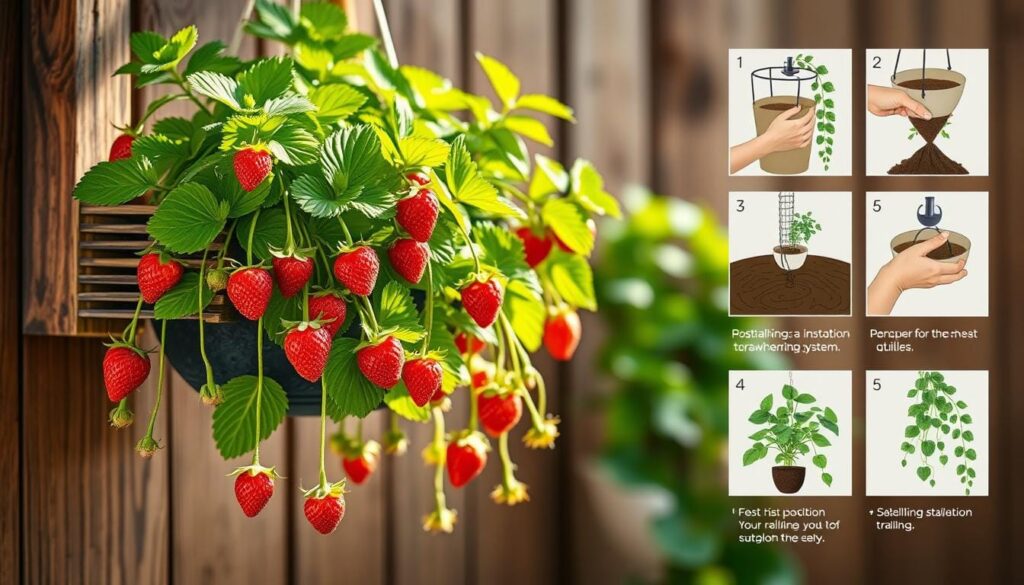
Step-by-Step Planting Guide
- Put coconut coir or landscape fabric in the container to keep moisture in but let water out.
- Fill it up to two-thirds with a mix of potting soil and compost.
- Put strawberry seedlings 6–8 inches apart, making sure their roots spread out.
- Fill any gaps with soil, leaving the crown area open to avoid rot.
- Water it well until you see water coming out the bottom.
Proper Spacing and Arrangement
Too many plants can hurt fruit production. Follow these tips for the best results:
- Small containers (12–18 inches): plant 2–3 seedlings
- Large hanging baskets (3–4 feet): space plants every 10 inches
- Arrange plants in a spiral pattern to get more sunlight
For DIY hanging strawberry plant setups, make sure the rope or chains can hold the weight. Place plants so their runners can hang down, making a beautiful display. Adjust the spacing based on the plant size—alpine strawberries need less space than June-bearing ones. Doing it right now will lead to a big harvest later.
Watering Requirements for Hanging Strawberry Plants
Proper watering is key for hanging strawberry plants to thrive. Knowing the right amount and frequency is vital. These tips for hanging strawberry plants will guide you to avoid common mistakes.
Frequency and Amount of Water
Adjust your watering based on weather and the type of container:
- Check the soil moisture every day. Water when the top inch feels dry.
- Water until liquid drains from the pot’s bottom. This ensures the roots are fully saturated. Don’t let water collect in saucers.
- In hot weather, water every 1–2 days. In cooler weather, water every 3–4 days.
Signs of Overwatering and Underwatering
| Issue | Symptoms | Solutions |
|---|---|---|
| Overwatering | Yellow leaves, mold on soil, mushy stems | Stop watering until the soil dries. If there’s root rot, repot with fresh soil. |
| Underwatering | Wilting, crispy leaf edges, slowed growth | Water more often. Soak the soil well to balance moisture. |
Regular checks prevent harm. Adjust your routine as the seasons change and the plant’s health evolves.
Fertilization Tips for Strawberry Plants

Proper fertilization is key for hanging strawberry plants. It boosts fruit yield and keeps plants healthy. Don’t overdo it with nitrogen-rich feeds. This can make leaves grow too much and overshadow the berries. Here are some tips for the best nutrition:
Recommended Fertilizers
- Choose balanced organic fertilizers like 10-10-10 NPK blends for balanced growth.
- Slow-release pellets are great for containers because they release nutrients slowly.
- For more frequent feeding, use liquid solutions at half-strength.
Hydroponic setups can also use these methods. Check out this guide for tips on managing nutrients precisely.
Signs of Nutrient Deficiency
| Nutrient | Symptom | Solution |
|---|---|---|
| Nitrogen | Yellow lower leaves | Apply a balanced fertilizer |
| Phosphorus | Purple stems or leaves | Use bone meal or high-phosphorus mixes |
| Potassium | Brown leaf edges | Apply potassium-rich sprays |
Check your plants’ leaves every week. This helps catch problems early. Adjust your fertilizers based on how your plants respond. This will help them grow strong and produce lots of fruit.
Pest Management for Hanging Strawberries
Keeping your hanging strawberry plant care healthy means watching out for pests. Hanging systems help avoid ground pests like slugs. But, they can face problems from flying bugs. Catching pests early by checking your plants weekly can stop them from spreading.
Common Pests and Their Control
| Pest | Signs | Control Methods |
|---|---|---|
| Aphids | Yellow leaves, sticky residue | Wash with water spray |
| Spider Mites | Fine webs, yellow speckles | Neem oil sprays |
| Fruit Flies | Rotten berries, eggs near stems | Apple cider vinegar traps |
| Birds | Missing berries, peck marks | Netting over containers |
Natural Remedies and Organic Solutions
Here are some tips for hanging strawberry plants to fight pests:
- Introduce ladybugs to eat aphids
- Make insecticidal soap: Mix 1-2 tbsp dish soap with water, spray weekly
- Apply neem oil every 7-14 days as a repellent
Regularly trim off damaged leaves and don’t overwater. This helps avoid attracting mites. Also, rotate your plants to break pest cycles. Using these methods together keeps your plants safe and eco-friendly.
Harvesting Your Strawberries
Harvesting your strawberries is the sweetest part of growing a hanging strawberry plant. It’s all about timing and technique for the best flavor and freshness. Here’s how to get the most from your plant:
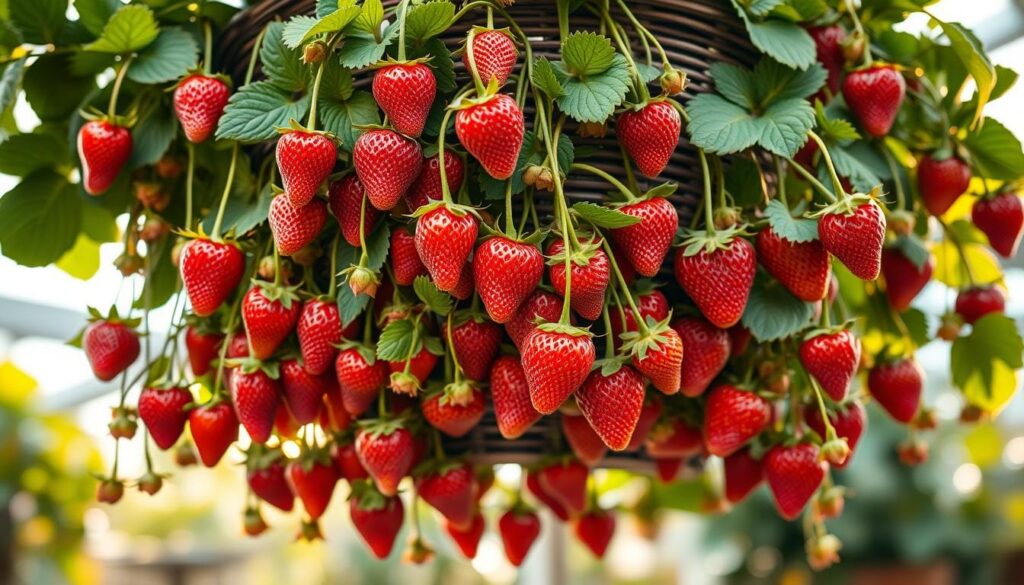
When to Harvest
Strawberries are ready when they’re fully red, firm, and smell sweet. Check your plant every 1-2 days when it’s in season. Waiting too long can make berries spoil, while picking too early can reduce flavor.
How to Properly Pick Strawberries
- Use clean scissors to cut stems ¼ inch above the fruit.
- Avoid pulling berries to prevent stem damage or plant stress.
- Discard overripe or damaged berries to discourage pests.
Store picked berries in a single layer in shallow containers. Use dry paper towels to absorb moisture. Keep them in the fridge within 2 hours for longer life. Harvesting in the morning keeps berries fresh.
Proper transplanting, as detailed in guides like this resource, ensures healthy plants ready for harvest. Regular checks and gentle handling reward you with fresh, juicy berries all season.
Tips for Year-Round Strawberry Production
Keep your hanging strawberries producing all year by changing their environment and care. These tips work for both indoor and outdoor plants, keeping them healthy through every season.
Indoor vs. Outdoor Growing
Start by knowing the differences between indoor and outdoor growing. Indoor hanging strawberry plant setups need artificial light (12–16 hours daily) and constant humidity. Outdoors, pick a spot with morning sun but sheltered from harsh weather.
Indoor plants need manual pollination and avoid extreme weather. Outdoor plants rely on natural cycles but face seasonal challenges.
Seasonal Care Guidelines
Here are the best care tips for hanging strawberry plant care through the seasons:
- Winter: Move plants indoors if frost is likely. Use LED grow lights and keep temperatures between 65–75°F. Pollinate flowers with a soft brush.
- Spring: Fertilize every 3 weeks with a 10-10-10 mix. Remove dead leaves to improve airflow.
- Summer: Water in the morning to avoid heat stress. Shade plants during the hottest part of the day if it’s over 85°F.
- Fall: Water less as growth slows. Pick the last fruit before the first frost.
Choose everbearing varieties like Tristar or Ozark Beauty for a longer harvest. Adjust your schedule based on your local climate for consistent yields.
Troubleshooting Common Issues
Even with the right hanging strawberry plant care, problems can happen. Spotting issues early is key to saving your crop. Regular checks and fast action help your plants stay healthy.
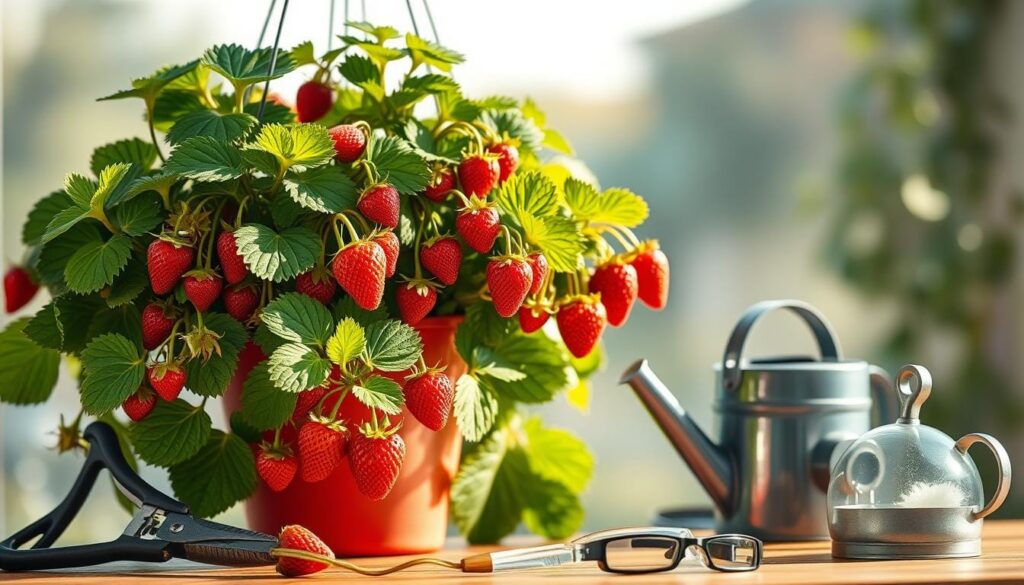
Disease Management
Some common diseases include:
- Powdery mildew: White powder on leaves. Use neem oil to treat. Prune plants to improve air flow.
- Leaf spot: Brown spots on leaves caused by moisture. Remove infected leaves. Copper-based sprays can prevent it.
- Gray mold: Fuzzy gray growth on fruit. Remove affected berries. Water roots, not leaves, to reduce humidity.
Environmental Stress Factors
Stress signs often mean your plants are not in the right conditions:
- Heat stress: Wilting leaves. Move plants to partial shade and water in the morning.
- Cold damage: Limp leaves after frost. Use frost cloth to cover plants at night.
- Sunscald: Yellow patches on leaves. Provide shade during the hottest sun hours.
- pH imbalance: Yellowing leaves. Test soil pH yearly. Adjust with lime or sulfur as needed.
Important tips for hanging strawberry plants include checking soil pH yearly and rotating containers yearly. This prevents disease buildup. Proper spacing in containers also helps reduce mildew risks. Regular checks and quick action keep your hanging garden productive.
Creative Ways to Use Hanging Strawberry Plants
Turn your hanging strawberry plant into a kitchen must-have and a chic decor piece. These hanging strawberry plant ideas show how to get the most out of them. They’re great for cooking and decorating.
Culinary Uses
Harvested berries are sweeter than store-bought ones. Try these recipes:
- Blend into smoothies or yogurt parfaits for a vitamin boost.
- Freeze whole or slice into popsicles for summer treats.
- Make homemade jam using recipes from vertical garden projects.
Dehydrated strawberries keep natural sugars, great for snacking or baking.
Decorative Ideas for Your Home
Style your space with these hanging strawberry plant setups:
| Setup | Materials | Benefits |
|---|---|---|
| Vertical Tower | PVC pipes, net pots | Saves floor space |
| Living Wall | Wooden frames, pockets | Modern aesthetic appeal |
| Upside-Down Planter | Inverted hangers | Space-efficient growth |
Pair hanging planters with flowering vines for vibrant displays. Check design principles for year-round curb appeal.
Conclusion: Enjoying Your Vertical Strawberry Garden
Turning a small area into a strawberry garden is easy with a hanging strawberry plant. A strawberry plant hanger lets you grow delicious berries without a big garden. It’s both useful and stylish, showing that growing your own fruit is possible for everyone.
Final Thoughts and Encouragement
Even if you’re new to gardening, growing strawberries vertically is doable. Seeing your berries grow in a hanger is very rewarding. Start with one plant and add more as you get better. The taste of your own strawberries and the pride of growing them vertically make it all worth it.
Connecting with Local Gardening Communities
Local resources like university extensions or groups like the National Garden Club offer great advice. Online forums and social media groups like #VerticalGardening also help. Sharing your experiences with others or joining community gardens can teach you a lot. These connections help turn problems into chances to learn.
